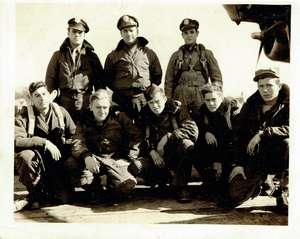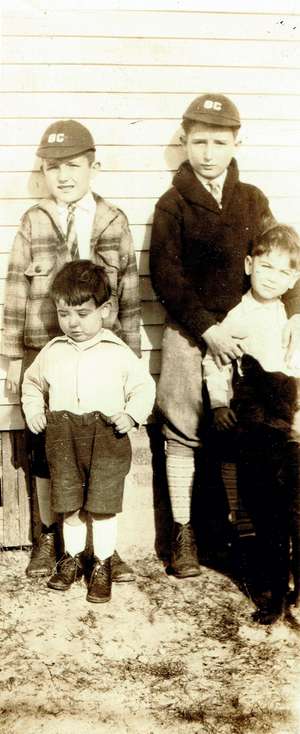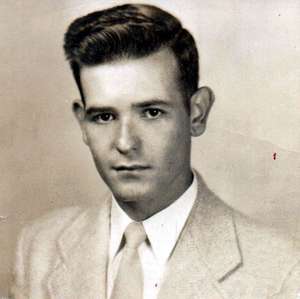Roy Irving Hussey
A Great Gentleman
In April of 1939 the New York World's Fair, "Building The World of Tomorrow," opened on what was once a marshy wasteland in Flushing Meadows, New York. Two months later Roy embarked on a great adventure when he left Savannah to visit his brother Tom who was living and working in New York City. Ruth Holmes, Tom's soon to be wife, and Roy drove to New York from Savanannah. Tom provided Roy with directions to the New York Subway System and while Tom was at work, Roy was free to roam New York. He was a frequent visitor to the World's Fair, Coney Island and other sights of interest to a young man of 15 years visiting the Big Apple for the first time.
Roy graduated from Savannah High School in June, 1943 and enlisted in the Army Air Force in August of that year. After induction at Fort McPherson, Georgia, Private Roy Hussey entered the Aviation Cadet Program with Basic Training at Keesler Field in Biloxi, Mississippi on Sept 7, 1943. He advanced to the academic portion of the program at the University of Toledo in October 20, 1943. Here the Army had contracted with the University to house, feed, and instruct pre-cadets in basic science. Military subjects and drills were included as well and were conducted by military personnel.
At the beginning of 1944, Cadet Hussey was ordered to San Antonio, Texas for "Classification", where he had to pass rigorous physical and aptitude examinations to qualify for flying duty. The classification center's purpose was to steer cadets toward the aviation specialty to which they were best suited. This involved long series of physical and mental tests. Among those that eliminated some aspirants were a test of depth perception and a test of ambidexterity. The aggregate aptitude rankings (from 1 to a high of 9) required were navigator-9, pilot-8, and bombardier-8. Drills, parades, lectures, and casual duties kept the cadets busy between tests. Now classified as a potential Navigator, Roy entered Pre-flight training on Feb 25, 1944. Pre-flight was a continuation of Classification without the tests and did not involve flying. Finally in June, it was time for Navigation training at Ellington Field, Texas. The concentration was on the serious business of learning aerial navigation as well as the complexities of weather and recognizing planes and ships of friends and foes. The basics of radio communication were learned and each cadet had to pass a Morse Code test of sending and receiving dots and dashes at the rate of six words a minute. At Ellington they were finally flying. The small cabin of twin-engined AT-7s carried an instructor supervising three cadets, each furnished with desk and instruments showing the plane's airspeed and altitude. Here using the plane's instruments, the drift meter, a circular slide rule and a protractor/ruler, they plotted their course by estimating ground speed and relative wind. They were graded not only on the accuracy of their plot but also on how well they recorded important data on their log of the flight. On October 2, 1944, Cadet Roy Hussey graduated and was commissioned 2nd Lieutenant Roy I. Hussey, O-2072464, MOS 1034 [Military Occupational Specialty: Navigator].
After home leave in Savannah and New York, he was ferried to England where he was assigned to the 8th Air Force, 1st Air Division, 398th Bombardment Group (Heavy) known as "Hell from Heaven" stationed in Nuthamstead, England. Roy joined a B-17G Flying Fortress crew of the 603rd Squadron known as Donovan's crew. He would finish the war with the same crew and the same plane, which the crew never named. During the last two months of the war, Roy flew 18 missions in the final push to VE Day. For more on the missions he flew, click here
With the war over, Roy's trip home involved navigating the B-17G and it's crew across the Atlantic. On June 2, 1945 they made the hop from Nuthampstead, England to Iceland. From there they flew to Greenland and then on to Labrador and finally Drew Field, Florida, which is today Tampa International Airport. In total the trip took 5 days. The 603rd was deactivated on September 1, 1945 at Drew Field, Florida.
Roy made the transition to civilian life by attending Georgia Institute of Technology where on June 12, 1950 he graduated with a Bachelor of Industrial Engineering degree. Returning to Savannah, he took a position with Thomas & Hutton Engineering. He gained experience and progressed through numerous projects and assignments. On March 29, 1961 he resigned and joined with Ben Gay to form Hussey & Gay, which later became Hussey, Gay & Bell. The firm and its international subsidiaries have completed world-class projects in the Middle East, Australia, Central and South America, as well as a myriad of projects from North Carolina to Florida. Notable local projects include The Landings on Skidaway Island, Palmetto Dunes on Hilton Head Island and the Savannah Riverfront Restoration. The Savannah Riverfront Restoration project received the U.S. Department of Interiors highest award for the conservation and preservation of the nations cultural heritage. Hussey, Gay & Bell continues today as one of the most respected engineering firms in the region.
Photographs & Documents
Click an image to view larger





